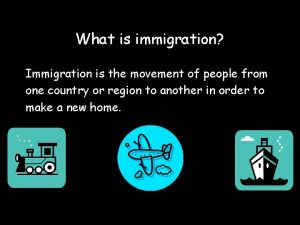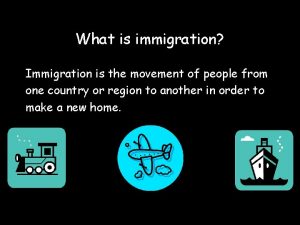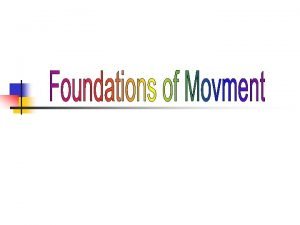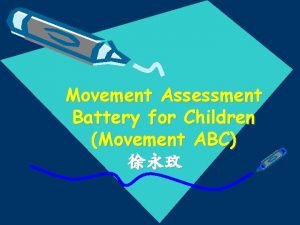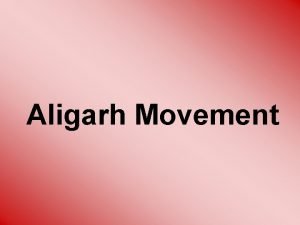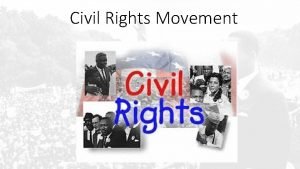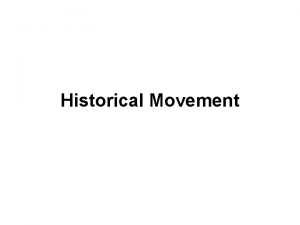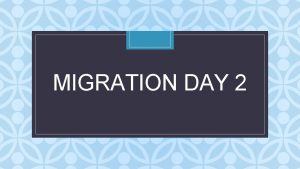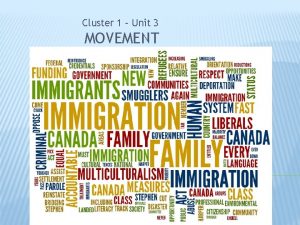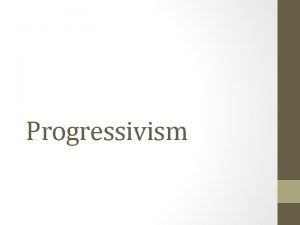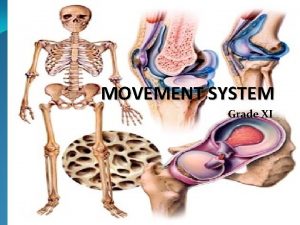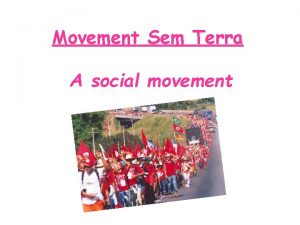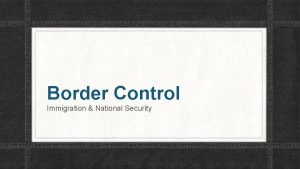What is Immigration Immigration is the movement of























- Slides: 23

What is Immigration? Immigration is the movement of people from one country or region to another in order to make a new home.

What is an immigrant? An immigrant is a person who moves from one country or region to another in order to make a new home.

Why do people move? People immigrate because of push factors or pull factors.

Push Factors: Why leave home? • Persecution because of religion Examples: Jews, Mennonites and Doukhobors of Russia • • Persecution because of culture Compulsory military service Inability to buy their own land Overcrowding on small plots of land. Lots too small to make much $; land too poor to grow much • Unemployment

Push Factors (cont. ) • • Wars High crime rate e. g. Mexico Natural disaster e. g. Haiti Poor education system Inability to get citizenship Poor health care No freedom

Who left their country when and what pushed them Who When Number Why Irish 1840 s-1850 s 1. 5 Million Potato crop failure and famine Germans 1840 s-1880 s 4 Million Economic depression, unemployment and political instability Danes, 1870 s-1900 s 1. 5 Million Poverty and shortage of farmland Norwegians, and Swedes Poles 1880 s-1920 s 1 Million Poverty, political repression, and a cholera epidemic Jews from 1880 s-1920 s 2. 5 Million Religious persecution Eastern Europe Austrians, 1880 s-1920 s 4 Million Poverty and overpopulation Czechs, Hungarians, and Slovaks Italians 1880 s-1920 s 4. 5 Million Poverty and overpopulation Mexicans 1910 -1920 s 700, 000 Mexican Revolution in 1920; low wages and unemployment Source: World Book Encyclopedia

Anniversary of Operation Stork: Ministers Kenney and Oda meet with some of the families helped by the special initiative, January, 2010 Program to transport Haitian children cleared by the Government of Haiti for adoption following the earthquake

Syria Refugees

Prime Minister Justin Trudeau

Trudeau and Wynne

Story #1 What is pushing Li’s family to leave China? My father came to Canada in 1912 to search for a better life. There were no jobs in our small village of Goon Do Hung in southern China. My father needed money to take care of his new family and his widowed mother. When he first arrived in Canada, he did any kind of job he could get. After a while, he became an apprentice in a friend's herbal store. Father came home once or twice that I could remember. He could never stay long because he had to go back to Canada to work. He never mentioned that someday that he wanted to take us to Canada, but he was thinking about it. On his last visit home, he was sad at how poor the villagers were. They made a living by planting rice crops. People were so poor that no one had milk to drink or had much meat to eat. Almost no one had ever learned to read or write. So my father decided that his family must immigrate to Canada to have a better life. When we decided to leave, it was 1933. I was only seven years old. From Li Keng Wong published at http: //www. scholastic. com

Story #2 What is pushing Seymour’s family to leave Poland? My name is Seymour Rechtzeit and I was born in Lódz, Poland, in 1912. My family is Jewish, and I first began singing in our temple. By the time I was four, I was called wunderkind, or wonder child in English. Soon I was singing in concerts all over Poland. My family decided that I should come to Canada, where there would be more opportunities for me. World War I had just ended, and it was a bad time in Europe. I had an uncle in Canada, and he sent two tickets for my father and me. The rest of my family stayed in Poland. The plan was that my father and I would make enough money to bring them to Canada too. In Danzig, now known as "Gdansk, " we boarded a ship called The Lapland. It was 1920, and I was on my way to Canada. From Seymour Rechtzeit published at http: //www. scholastic. com

Pull Factors: Why Canada? • • • Lots of land (free in 1900 s) Advertising campaign Free health care Good education Well paid jobs Peaceful country: low crime rate No military service requirement Freedom of religion, language Clean air and water Family reunification

Ad #1 This ad from 1890 says, “Canada, 160 acres of free land for every settler” How is this ad trying to pull people to Canada? Ad From: http: //www. cic. gc. ca/english/department/legacy/chap-2. html

Ad #2 How is this ad trying to pull people to Canada? Ad from: http: //www. saskschools. ca/~lyndale/canweb. html

Why leave Toronto? • • • Change of family situation Loss of job Dirty air High rents/ housing costs Traffic congestion

What’s pulling people to other places in Canada? • • • Educational opportunities New job Better climate Family reunification Better housing for less $ New friends

Legal Immigration • • Federal skilled workers Canadian Experience Class (12, 000 max) Family sponsorship Start-up visas (minimum investment of $200, 000) Self-employed (including farmers) Live-in caregivers Refugees

Family Sponsorship • • If you are a Canadian citizen or permanent resident, you may sponsor: your spouse, common-law partner or conjugal partner dependent children parents grandparents

Refugees • Persons in need of protection within or outside Canada who fear persecution or are at risk if they go back to their home country • Video: http: //www. youtube. com/watch? v=_t. P_2 Ak. GOr. U &list=PLDC 705438 C 908995 C&index=3 • Referrals from United Nations High Commissioner for Refugees (UNHCR) Canada: A History of Immigration http: //www. cic. gc. ca/english/games/teachers-corner/refugee/flash. asp

What do these people have in common?

Special Canadian Citizenship Malala Yousafzai joined five other courageous and historic figures in 2013 when Canada confered honorary citizenship on the 16 -year-old Pakistani girl. Malala joined the distinguished ranks of Swedish diplomat Raoul Wallenberg, Nelson Mandela, The Dalai Lama, Aung San Suu Kyi and The Aga Khan. "Our government will bestow honorary citizenship on Malala Yousafzai who courageously advocates for human rights and freedom against the backdrop of Taliban extremism and oppression. "

Immigration Myths http: //www. cic. gc. ca/english/department/media/facts/index. asp Santa Claus’ citizenship re-affirmation at a special citizenship ceremony in Calgary. December 22, 2010
 Light gun signals
Light gun signals Is an axial movement.
Is an axial movement. Bảng số nguyên tố lớn hơn 1000
Bảng số nguyên tố lớn hơn 1000 Công của trọng lực
Công của trọng lực Tỉ lệ cơ thể trẻ em
Tỉ lệ cơ thể trẻ em đặc điểm cơ thể của người tối cổ
đặc điểm cơ thể của người tối cổ Các châu lục và đại dương trên thế giới
Các châu lục và đại dương trên thế giới ưu thế lai là gì
ưu thế lai là gì Thẻ vin
Thẻ vin Các môn thể thao bắt đầu bằng từ đua
Các môn thể thao bắt đầu bằng từ đua Tư thế ngồi viết
Tư thế ngồi viết Bàn tay mà dây bẩn
Bàn tay mà dây bẩn Hát kết hợp bộ gõ cơ thể
Hát kết hợp bộ gõ cơ thể Từ ngữ thể hiện lòng nhân hậu
Từ ngữ thể hiện lòng nhân hậu Trời xanh đây là của chúng ta thể thơ
Trời xanh đây là của chúng ta thể thơ Tư thế ngồi viết
Tư thế ngồi viết Gấu đi như thế nào
Gấu đi như thế nào Thế nào là giọng cùng tên
Thế nào là giọng cùng tên Thơ thất ngôn tứ tuyệt đường luật
Thơ thất ngôn tứ tuyệt đường luật Hổ sinh sản vào mùa nào
Hổ sinh sản vào mùa nào đại từ thay thế
đại từ thay thế Thế nào là hệ số cao nhất
Thế nào là hệ số cao nhất Diễn thế sinh thái là
Diễn thế sinh thái là Vẽ hình chiếu vuông góc của vật thể sau
Vẽ hình chiếu vuông góc của vật thể sau



























